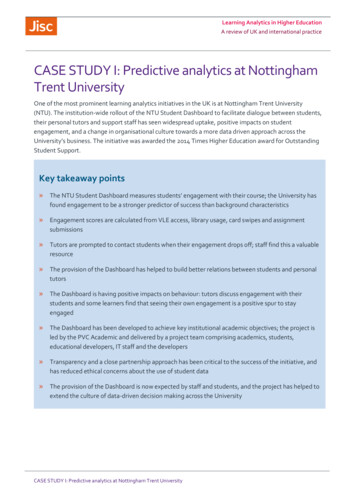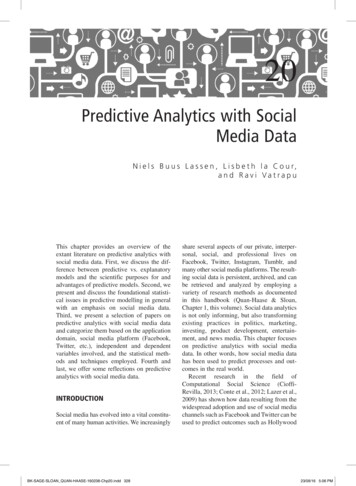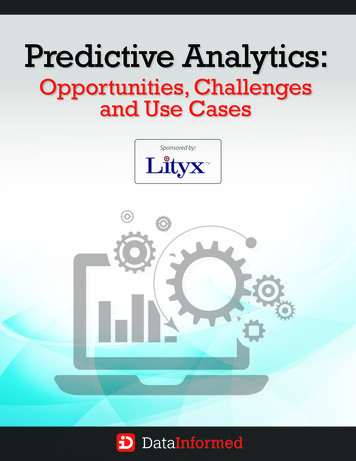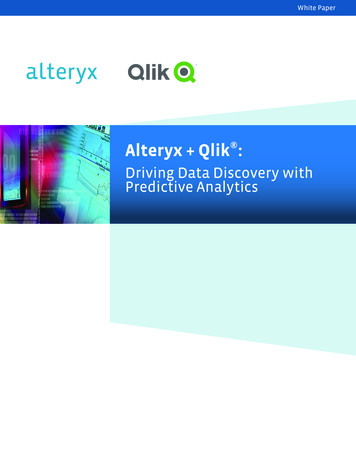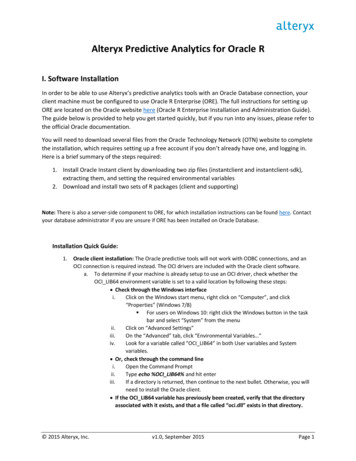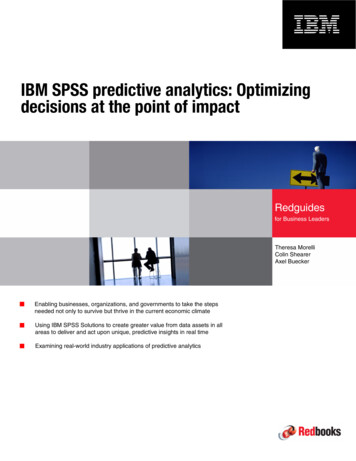
Transcription
Predictive Project AnalyticsHindsight Insight Foresight
Today’s project landscapeToo many projects continue to failThere have undoubtedly been huge steps forward in the sphere ofproject management. But despite the rise of standardizedmethodologies, sophisticated management techniques andinternationally recognized accreditation bodies, consistent successremains elusive.45% Of projects go over-budget56% Of projects deliver less value than predictedUS 122 million amount lost on averagefor every US 1 billion spent on projectsWhichever parameters you’re using to define success, it’s clear thatthere remain fundamental problems.Soft Factors remain an elusive threatWhile the development of standardized methodologieshas contributed much to project management, thesego-to best practices have also become more and morecomplex rather than improving awareness around theinfluence of soft factors. Standardized methodologiesdon’t account for flaws in human nature. The presenceof cognitive bias and social dynamics should compelproject leaders to seek a more specialized approach.Confirmation bias is a great example of the impact ofsoft factors. People disproportionately seek and weightevidence that supports their world view / hypothesis.In project terms, evidence that supports planningassumptions may be utilized in endorsement whereasevidence that contradicts planning assumptions maybe downplayed, discredited or disregarded.Over reliance on expertise is another growing trend.Subject matter expertise can be dangerously confusedwith delivery expertise. Track record of expertise inestimating project complexity is poor even whencompared against the simplest algorithms.Furthermore the positional authority of ‘experts’ canclose-down rational dissent.The results are predictable: disregarded soft factorsare hitting projects hard.Source: (1) “Delivering large-scale IT projects on time, on budget, and on value” - Michael Bloch, Sven Blumberg,and Jürgen Laartz, 2012 (2) PMI’s Pulse of the Profession: The High Cost of Low Performance, February 2016 2017 DeloittePredictive Project Analytics1
Introducing Predictive Project AnalyticsA new way of safeguarding your investmentFrom Hindsight to ForesightPredictive Project Analytics (PPA) is an analytical assessmentcapability that examines a project’s characteristics and uses analgorithm based on a large dataset of previous projects to identifythe best methods to effectively manage it.Hindsight Insight ForesightIn three steps you gain practical insights into your project’s risks,performance and practical recommendations to improve projectdelivery.Hindsight: Our predictive algorithm is grounded inyears of project data, allowing your execution tobenefit from lessons learned around the world.Insight: Harness tools to monitor progress in realtime, assess the competency of your team and createa risk profile tailored to your project.Foresight: Our inference algorithm can point youtoward areas of risk before damaging situations occur,allowing you to correct mistakes before they happenUnderstand theproject’s complexity 2017 DeloitteIdentify the project’scontrol gapsImprove projectdeliveryperformancePredictive Project Analytics2
Understand the project’s complexityLike a human fingerprintComplexity ReportingEach project has its own unique complexity profile. PPA identifies thekey project characteristics that drive complexity based on a set ofstatistically significant drivers of risk.DECISION MAKINGAssesses the complexity of decision-making related to the type ofdecisions, number of stakeholders and their interestsBEHAVIORAL CHANGEAssesses the challenges for the project associated with humanchange managementUNCERTAINTYAssesses the challenges related associated with uncertainty andriskUnderstand what isdriving complexityon your projectacross 47complexity factors,28 complexitydrivers, within 5categories.TECHNICAL RISKSAssesses the challenges associated with the required technical orsystem changes (IT, telecommunications, engineering,production, control etc.)DELIVERY MANAGEMENTAssesses the challenges linked to planning, project managementand execution of project activities 2017 DeloittePredictive Project Analytics3
Identify the project’s control gapsRight sized project controlsBased on project complexity, the PPA Analytical Engine determines thelevel of control necessary to achieve success across 7 domains.OWNERSHIPAssesses the leadership provided by accountable senior managersand the level of executive support and direction provided to theproject.Project Control ReportingAssess project executionactuals versus expectedperformance to determinegaps in control.GOVERNANCEAssesses the approaches used by the organization to ensure thatthe correct decisions are made, in the correct timeframe, by thecorrect individuals or groupsRISK MANAGEMENTProcesses, methods and policies that relate to strategic andtactical risk management for projects.RESOURCE MANAGEMENTEvaluates the systems, approaches and methods used to ensurethat projects are provided with the organizational resourcesrequired to deliver the project successfully.DELIVERY MANAGEMENTEvaluates the management approaches that the organizationuses to deliver projects. It covers how projects plan, scheduleand manage activities and delivery into the organization.CHANGE MANAGEMENTAssesses methods, processes, roles and tools used to manageexpectations, involvement, acceptance and other activitiesrelating to impact on end users.CONTRACT MANAGEMENTAssesses the significant contractual components and approachesused to ensure effective contract management from theperspective of both the buyer and the providers. 2017 DeloittePredictive Project Analytics4
Improve your project’s delivery performancePPA has made a big impact for our clientsOver 8 years in development, Predictive Project Analytics hasreceived external recognition from Gartner, and has provedeffective in over 120 Billion of project investment.Our project analytics services lead the way in risk managementconsultancy, and have been successfully applied in more than 200projects of all types, sizes and industries around the world.Predictive Project Analytics is a unique Deloitte solution validated inpartnership with academics and refined every year throughthorough statistical analysis.For the first time a comprehensive range of human factors havebeen taken into account beside industry, project and size specificrisks.The Value Delivered Fast identification of critical performance issues andkey risk areas Innovative, fact-based and objective Highly visualized project risk data to bettersupport rapid decisions making 2017 DeloitteScientific RigorAt the heart of PPA, the predictive and analyticcapabilities are data-driven. Our algorithms have beendeveloped with years’ worth of project data, pickedapart to extract the details now proven to helpprojects succeed. This ensures that your projectbenefits from lessons learned around the world.While Predictive Project Analytics may be founded onpast data, it is so much more than a simplebenchmarking tool. Our extensive collection of projectdata is the basis of a sophisticated inference engine,which collates 50 complexity factors and 172 executioncontrols.Once armed with the expected levels of each controlfactor, a gap analysis highlights areas which require ahigher or lower level of control. If you are operatingwith a different level of control than we wouldrecommend, the Inference Engine points to practical,corrective action which can be taken to help bringabout your project’s success. The result is anadaptable, data- driven engine proven to guide yourproject in the right direction.To keep our inference engine as accurate as possible,project feedback is regularly incorporated, forming aself-learning loop to ensure Predictive Project Analyticsbecomes more valuable with every use.Predictive Project Analytics5
How to use Predictive Project AnalyticsPPA in a DayPPA PortfolioFast, interactive, insightfulAn interactive day of facilitated selfassessment for projects using analytics ina Highly Immersive Visual Environment(HIVE). PMs review the project’scomplexity profile and assess projectexecution practices across 172 projectmanagement factors.Confidence in portfolio performancePragmatic and effective method ofdetermining where the highest levels ofrisk are across your portfolio.PPA-in-a-Day provides quick and practicalinsights on the project performance in oneday, using leading edge project analytics.Portfolio Managers gain an understandingof the relative performance of the projectsin their portfolio and have access toobjective data for better resourceallocation or decision making, and insightinto potential systemic issues.Project Quality AssuranceProject Team CompetencySafeguarding investment & delivery4-6 week Subject Mater Expert reviewsusing PPA to provide an objective andindependent assessment. This approachinvolves interviews across keystakeholders / project streams anddeliverable reviews to capture both broadand deep visibility into the project.The right team right nowUse PPA to assesses individuals againstproject complexity characteristics to helpyou build the best team possible. Appliedat a project level, this removes theguesswork from selecting projectmembers, while highlighting your team’sstrengths and weaknesses relative toproject requirements.The outcome is comprehensive reportingof issues with tailored and prioritizedrecommendations that will ensure yourproject is positioned to deliver. 2017 DeloittePredictive Project Analytics6
PPA in a DayFast, interactive, insightfulOne of the most powerful advantages of analytics is that it helps us befaster. PPA in a Day demonstrates this key analytical principle.PPA in Day Sample ReportingPMs join Deloitte SMEs for a day to walk through their project’s executionperformance through a facilitated interactive workshop. This one day ofinvestment results in PMs understanding if their project is on track forsuccess and if not, then they will be armed with implementablerecommendations to enhance delivery performance.Also, different than traditional project reviews, PPA in a Day is anexperience for PMs to gain new insights and different perspective onproject challenges in a collaborative environment.Overview of the PPA in a Day approach23Prep-call aheadof the workshopParticipants completePPA complexityquestionnaire 2017 Deloitte4Participants join a fullday workshop withDeloitte SMEsreviewing their projectand discussing resultsPost- sessionPre- sessionParticipantsreceive PPA intromaterialsPPA in a Day15Deloitte publishesreports toparticipants6Follow-up callto answerquestions &discuss results(as needed)Predictive Project Analytics7
Project Quality AssuranceSafeguarding investment & deliveryLarge complex projects require strong Quality Assurance programs toensure success. Using the PPA capability, Deloitte Subject Matter Expertsconduct objective and independent assessment of your project.Sample PPA Deep Dives DeliverablesThis approach involves interviews across key stakeholders / projectstreams to gain a broad understanding of project performance and riskareas. SMEs also perform deliverable reviews to substantiate interviewsand develop a deep understanding of project delivery management.Detailed complexity profileInterview and deliverable output is assessed using the PPA capabilitydetermine gaps in performance based on the project’s unique complexityprofile. SME guidance further tailors recommendations to optimize andaccelerate positive impact on project performanceGap analysis of performance factorsOverview of the PPA Quality Assurance approachDetailed findings, themes, and rootcauses of project challengesPrioritized recommendations andaction plans for improvement 2017 DeloittePredictive Project Analytics8
PPA credentialsShipyardAn international shipyard company has launched a program to standardize their product lifecycle managementprocesses. The program will have a large impact on the total organization. Not only processes and governancemechanisms will change, also the organization culture will largely be impacted. The company asked Deloitte toperform a program review using PPA in a Day. The result of the one day session identified four critical areas ofrisk and outlined practical follow up actions to increase the program performance.HealthcareDeloitte’s client had embarked on a large program to implement Electronic Health Record software. Deloitte wasengaged to perform the Quality Assurance role on the program. As part of the approach, PPA was used to assessthe program complexity and control mechanisms in order to determine which improvements were necessary.Based on the results, several risks in the program set-up were identified. The PPA review provided the Board ofDirectors with actionable improvement measures, which were approved, implemented and resulted in positiveimpact to the program’s delivery.FinancialServicesDeloitte was asked to assess the viability and direction of a compliance program scheduled for global rollout in acomplex regulatory and stakeholder environment. By applying PPA, Deloitte was able to provide additional factbased insights and direction to support the project review findings. By combining the results with insights from aseparate risk-analysis work stream, the assessment team delivered a holistic review of the project performancewith a risk-analysis deep dive. The review ultimately supported the decision to change the strategic direction ofthe project due to the objective, data driven information available to Senior Management.Oil & GasDeloitte was engaged to complete retrospective project reviews on five large Capital Projects to define complexitylevels and expected project performance. The PPA capability demonstrated the value of quantitative risk data andits ability to provide a foundation for an analytically driven project management framework. The PPA capabilitywil
Today’s project landscape Predictive Project Analytics 1 Soft Factors remain an elusive threat While the development of standardized methodologies has contributed much to project management, these go-to best practices have also become more and more complex rather than improving awareness around the influence of soft factors. Standardized methodologies don’t account for flaws in human .

